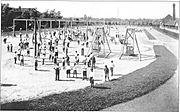Douglass Park facts for kids
Quick facts for kids Douglass (Frederick and Anna) Park |
|
|---|---|
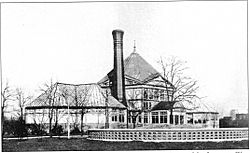
This Douglas Park Greenhouse was torn down in 1905.
|
|
| Type | Municipal |
| Location | Chicago, Cook County, Illinois |
| Area | 173 acres (0.70 km2) |
| Operated by | Chicago Park District |
| Open | All year |
Douglass (Frederick and Anna) Park is a large Chicago Park District park on the West Side of Chicago, Illinois. It's a special place for culture and community. The park began in 1869 and was first called South Park. It covers about 173 acres (0.7 square kilometers) in the North Lawndale neighborhood. Its official address is 1401 S. Sacramento Drive.
For 151 years, the park was known as Douglas Park. This name honored Stephen A. Douglas, a U.S. Senator before the American Civil War. In 2020, the park's name changed to Douglass (Frederick and Anna) Park. This new name honors the famous abolitionist Frederick Douglass and his wife, Anna Murray Douglass.
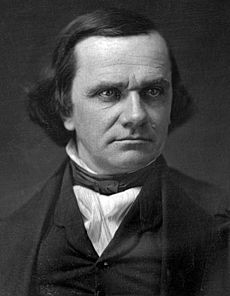
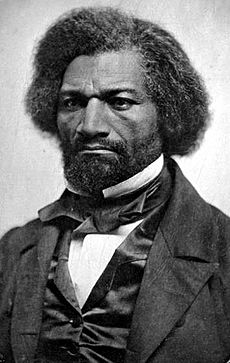
Park History and Design
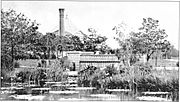
In 1869, the Illinois state government created the West Park Commission. This group was in charge of building three big parks and connecting roads. On November 4, 1869, the commissioners named the southernmost park after Stephen A. Douglas. Douglas was a U.S. Senator who helped bring the Illinois Central Railroad to Chicago. He is also remembered for losing the 1860 presidential election to Abraham Lincoln.
In 1871, a designer named William Le Baron Jenney made plans for the whole West Park System. This system included Douglas, Garfield, and Humboldt parks. Jenney was an expert in engineering. He helped turn Douglas Park's marshy land into a beautiful park. He added manure and sand to the wet ground. This helped raise the land to the right level. Jenney also created a pretty lake in the middle of the park. A small part of the park officially opened in 1879.
Building the park cost a lot of money. Also, collecting taxes was hard after the Great Chicago Fire. So, the park was built in stages. The first improvements were made by Oscar DuBuis in the 1880s. Between 1886 and 1888, Douglas Park got a conservatory, like other West Park System parks. In 1895, German turners' clubs asked for an outdoor gym. The next year, one of Chicago's first public outdoor gyms was built. It also had a swimming pool and a natatorium (an indoor swimming pool).
Changes in the 1900s
Around 1900, the West Park Commission had some problems. The three parks started to look run down. In 1905, as part of a reform effort, Jens Jensen became the main superintendent and landscape architect. Jensen is now known as a leader of the Prairie School style of landscape architecture. He fixed up the parks and added new things.
Jensen added a curved entrance at Marshall Boulevard. He also designed a formal garden at the corner of Ogden Avenue and Sacramento Drive. By the time Jensen designed the garden, Ogden Avenue was already built. This diagonal road had a major streetcar line and later became part of Route 66. The road split the park into two parts. It created a busy intersection where Ogden and Sacramento Avenues met. Jensen's idea was to create a long garden on the southeast side of the intersection. This garden acted as a buffer between Ogden Avenue and the playing fields to the south. Jensen also removed the conservatories in each of the West Park System parks. He wanted one grand conservatory at Garfield Park instead.
At the garden's entrance, near the busy road, Jensen placed a large garden shelter called Flower Hall. He also added a formal reflecting pool. The person who designed this building is not known for sure. It might have been Jensen himself or his friend, Hugh Garden. East of the building, the garden became more natural. Jensen included beds of flowers that bloom every year. He also added a lily pool and unique benches in the prairie style.
In 1928, the West Park Commission built a fieldhouse in Douglas Park. Architects Michaelsen and Rognstad designed it. They also designed other famous buildings in Chicago. In 1934, Douglas Park became part of the Chicago Park District. This happened when the city's many park commissions joined together.
Renaming the Park
In 2017, students started a petition to rename the park. They wanted to honor Frederick Douglass and his wife. In 2019, they presented their idea to the park district board. In 2020, the Chicago Park District Board approved the name change. They noted that they had never changed a park's name from a historical person before.
Today's Park Features
Douglass (Frederick and Anna) Park has always been a central spot for fun and activities. Today, the park has a miniature golf course. It also has five playgrounds and an outdoor swimming pool. You can find soccer fields, basketball courts, and an oval running track. The park still has its original lagoon and many different kinds of trees. The stone bridge designed by Jenney is also still there. The old greenhouse that drew visitors was taken down in 1905.
A statue of Czech patriot Karel Havlíček Borovský was once in the park. It was moved in 1981 to Solidarity Drive. This area is near the Adler Planetarium on today's Museum Campus. Chicago's plan to host the 2016 Summer Olympics included this park. They planned to have Olympic cycling events here, like a velodrome and a BMX course. Since 2015, the park has been the new home for the Riot Fest music festival.


